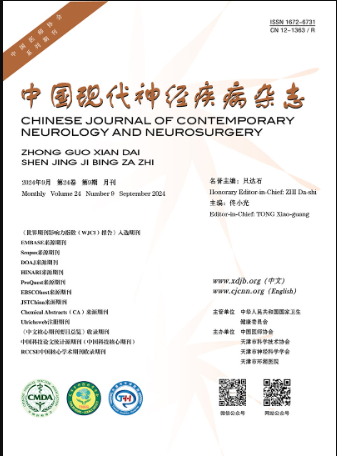Clinical phenotype and genetic characteristics of ataxia - telangiectasia: four cases report
Q4 Medicine
引用次数: 1
Abstract
Objective To report 4 cases of ataxia-telangiectasia (AT) with ATM genetic mutation and to summarize the clinical and genetic characteristics of AT by literatures review. Methods Clinical data of 4 patients from 3 AT families was collected in detail and genomic DNA of the patients and family members was extracted from peripheral blood. Whole exon sequencing (WES) and polymerase chain reaction (PCR) of Sanger sequencing was used to analyse ATM genic mutation. Results Four patients were characterized by progressive cerebellar ataxia with onset in childhood, oculocutaneous telangiectasia, recurrent infection caused by immunodeficiency, α-fetoprotein (AFP) elevation and cerebellar atrophy shown in brain MRI were presented. Sequence analysis of ATM gene revealed two known compound heterozygous mutations c.8287C > T (p.Arg2763X) and c.9139C > T (p.Arg3047X) which were nonsense mutation in Case 1 and Case 2. In Case 3, there were two compound heterozygous mutations, including nonsence mutation c.8911C > T (p.Gln2971X) and deficit mutation c.7141_7151delAATGGAAAAAT (p.Asn2381GlufsX18) both of which were not reported previously. Case 4 carried homozygotic mutation c.1402_1403delAA (p. Lys468GlufsX18). Conclusions Four patients were diagnosed as AT with typical clinical manifestations. Patients with variant AT present mild nervous system symptom, normal head MRI and less involvement other than nervous systemt. Definite diagnosis should be dependant on ATM genetic testing. DOI: 10.3969/j.issn.1672-6731.2017.07.008共济失调-毛细血管扩张症的临床表型和遗传特征:4例报告
目的报告4例伴有ATM基因突变的共济失调性毛细血管扩张症(AT),并通过文献复习总结AT的临床和遗传特征。方法详细收集来自3个AT家族的4例患者的临床资料,并从外周血中提取患者及其家族成员的基因组DNA。采用Sanger测序的全外显子测序(WES)和聚合酶链式反应(PCR)分析ATM基因突变。结果4例患者表现为儿童期发作的进行性小脑共济失调、眼皮毛细血管扩张、免疫缺陷引起的复发性感染、脑MRI显示的甲胎蛋白(AFP)升高和小脑萎缩。ATM基因序列分析显示两个已知的复合杂合突变c.8287C>T(p.Arg2763X)和c.9139C>T(p.Arg3047X)在病例1和病例2中为无义突变。在病例3中,有两个复合杂合突变,包括无序列突变c.8911C>T(p.Gln2971X)和缺陷突变c.7141_7151delAATGGAAAAAT(p.Asn2381GlufsX18),这两个突变以前都没有报道。病例4携带纯合突变c.1402_1403delAA(p.Lys468GlufsX18)。结论4例患者诊断为AT,临床表现典型。变异型AT患者表现出轻微的神经系统症状,头部MRI正常,除神经系统外参与较少。明确的诊断应该依赖于ATM基因检测。DOI:10.3969/j.issn.1672-6731017.07.008
本文章由计算机程序翻译,如有差异,请以英文原文为准。
求助全文
约1分钟内获得全文
求助全文

 求助内容:
求助内容: 应助结果提醒方式:
应助结果提醒方式:


